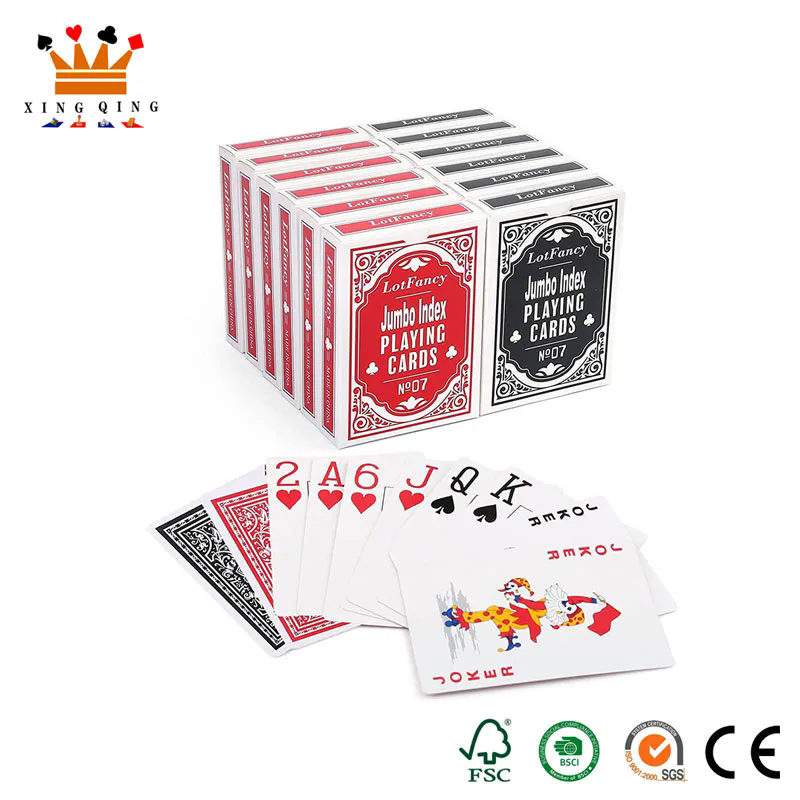Why Are Playing Cards Still So Popular in the Digital Age?
2024-11-07
In a world where smartphones, video games, and social media dominate our attention, one might wonder: why are playing cards still so popular? These small, simple rectangular pieces of cardstock, once primarily used for traditional card games, have managed to maintain their charm and relevance even in the digital age. Whether it's a family gathering, a night out with friends, or a casino setting, playing cards continue to offer an experience that digital alternatives can't quite replicate.
In this blog, we explore the enduring appeal of playing cards, examining why they remain a favorite pastime for people of all ages, and how they’ve adapted over the years to stay relevant in a fast-changing world.
The Timeless Appeal of Traditional Play
At its core, the beauty of a deck of playing cards lies in its simplicity. Unlike complex video games or online apps, all you need is a deck of cards and some willing participants. The rules are easy to learn, and the social interaction they foster is timeless. From classic games like Poker, Rummy, and Bridge to more casual ones like Go Fish or Snap, playing cards can accommodate a wide range of players and skill levels.
Playing cards bring people together, whether it's with family, friends, or even strangers. They facilitate interaction, laughter, and a shared experience—things that are often lost in the digital realm, where individual screens can sometimes create distance even among people who are in the same room.
Playing Cards: A Tradition Passed Through Generations
One of the reasons playing cards have maintained their popularity over the centuries is their role in bringing people together across generations. For many families, playing card games is a cherished tradition passed down from grandparents to parents and from parents to children. The act of teaching a child how to play a new game or learning a different strategy from a grandparent creates memories that last a lifetime.
For others, playing cards are a symbol of leisure and relaxation. Whether you're enjoying a quiet evening with a cup of tea or engaging in a competitive tournament with friends, playing cards offer a simple yet satisfying escape from the stresses of daily life.
The Evolution of Playing Cards
While playing cards have remained essentially the same for hundreds of years, the modern era has brought some exciting innovations to the world of card games. The introduction of novelty and themed card decks, for example, has transformed them from functional tools into collectible art pieces. Decks featuring everything from famous movie characters to intricate artwork have captured the imagination of collectors and enthusiasts alike.
Some brands have even created luxury playing cards made from higher-end materials like metal, wood, and plastic, offering durability and a unique tactile experience. Collecting rare or limited-edition decks has become a hobby in its own right, as enthusiasts seek out designs with artistic value or historical significance.
Moreover, the rise of online platforms has led to digital versions of classic card games, allowing players to enjoy the games from the comfort of their own homes or connect with others around the world. Yet, even with the convenience of digital play, there remains something special about handling the physical deck, shuffling the cards, and sharing a table with friends or family.
Playing Cards in Popular Culture
The enduring popularity of playing cards can also be seen in their role in popular culture. They have been featured in numerous movies, television shows, and even literature, symbolizing everything from luck and fate to deception and strategy. Think of the infamous card game scene in *Casino Royale*, or the iconic “deck of cards” in *Alice in Wonderland*. Playing cards have always been part of the fabric of storytelling, capturing the imagination of audiences around the world.
In fact, the symbolism of playing cards often goes beyond the games themselves. The design of the cards, with their suits and faces, has been interpreted as representations of social class, human traits, or even the passing of time. The unique art and design of each deck can tell a story, adding another layer of meaning to the cards.
Why Do People Still Choose Physical Playing Cards?
Even in a world full of advanced technology, physical playing cards have something digital formats lack. They are tactile. The feel of the cards in your hands, the sound of them being shuffled, and the way they glide smoothly as they are dealt—all of these are sensory experiences that no online game can fully replicate. This connection to the physical world provides an experience that many people still crave.
In addition, physical cards are portable and require no electricity, data connections, or software updates. Whether you're on a camping trip, at a family reunion, or simply relaxing at home, a deck of cards is always ready to go. There's no need for batteries, no risk of technological glitches, and no complicated setup. It’s as simple as it gets.
Conclusion: Are Playing Cards Here to Stay?
In an age dominated by digital entertainment, the enduring appeal of playing cards proves that sometimes, the simplest things are the most timeless. Playing cards offer a unique combination of social interaction, nostalgia, and tactile pleasure that digital games can't fully replicate. They continue to be a symbol of tradition, creativity, and fun, passed down through generations while simultaneously evolving to fit modern tastes.
So, are playing cards here to stay? The answer is a definitive yes. In fact, they’re likely to remain a beloved staple of social gatherings, game nights, and leisure activities for many years to come. Whether you’re a competitive poker player, a casual card gamer, or a collector of beautifully designed decks, the appeal of playing cards remains undeniable.



